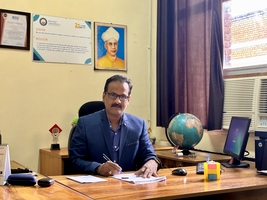School of Journalism and Mass Communication
Overview of the School
The School of Journalism & Mass Communication prepares students for dynamic media careers through industry-driven programs, blending theoretical knowledge with hands-on training. With state-of-the-art studios, editing suites, and a community radio station, students gain real-world experience in journalism, digital media, advertising, and corporate communication.
The curriculum integrates media ethics, investigative journalism, digital storytelling, and multimedia production, enriched by guest lectures, workshops, and internships with leading media houses, news agencies, and OTT platforms. Programs include B.A and M.A in Journalism & Mass Communication, B.A in Digital Journalism, B.Sc in Animation & Graphics, and specialized courses in Digital Media Production & Content Writing.
For research-focused careers, the Ph.D program offers deep insights into media theories and emerging trends. Backed by expert faculty, industry collaborations, and experiential learning, graduates emerge as versatile media professionals ready to excel in the ever-evolving media landscape.
Specialisation:
Specialisation is offered in the final year to undergraduate and graduate students for B.A JMC, B.Sc in Animation & Graphics and M.A JMC programs:
- Digital Journalism
- TV Journalism
- Animation & Graphics
Program Offered
Eligibility Criteria for Admission
The eligibility criteria for admission to various programs offered by the School of Journalism & Mass Communication vary depending on the level and nature of the program. Below are the typical eligibility requirements for each program:
1. B.A in Journalism & Mass Communication (B.A JMC)
Eligibility Criteria: Educational Qualification: Candidates must have completed their 12th grade (10+2) from a recognized board with any stream.
2. B.A in Digital Journalism
Eligibility Criteria: Educational Qualification: Candidates must have completed their 12th grade (10+2) from a recognized board with any stream.
3. B.Sc in Animation & Graphics
Eligibility Criteria: Educational Qualification: Candidates must have completed their 12th grade (10+2) from a recognized board with any stream.
4. M.A in Journalism & Mass Communication (M.A JMC)
Eligibility Criteria: Educational Qualification: Candidates must have a Bachelor’s degree from a recognized university with any stream.
5. Diploma in Digital Media Production & Content Writing
Eligibility Criteria: Educational Qualification: Candidates must have completed their 12th grade (10+2) from a recognized board with any stream.
6. Ph.D in Journalism & Mass Communication
Eligibility Criteria: Educational Qualification: Candidates must have a Master’s degree in Journalism & Mass Communication or a related field from a recognized university with a minimum aggregate of 55% marks.
Entrance Exam: Admission to the Ph.D. program typically involves an entrance exam.
Summary of the eligibility criteria:
|
Program |
Eligibility Criteria |
|
12th grade (10+2) in any stream from a recognized board. |
|
|
B.A in Digital Journalism |
12th grade (10+2) in any stream from a recognized board. |
|
12th grade (10+2) in any stream from a recognized board. |
|
|
Bachelor’s degree in any stream from a recognized university. |
|
|
12th grade (10+2) in any stream from a recognized board. |
|
|
Master’s degree in Journalism & Mass Communication or a related field with a minimum of 55% marks. |
Significant Highlights of the School
- Community Radio Station : Operates "107.8 Himgiri Ki Awaaz," a platform for practical training and community engagement.
- Comprehensive Internship Program : Final semester internships in leading media houses for B.A (JMC) and M.A (JMC) students.
- Expert Faculty : A team of highly qualified and experienced professionals, including Ph.D holders and NET-certified educators.
- Workshops and Guest Lectures : Regularly hosts renowned media professionals for interactive sessions.
- Modern Infrastructure : Equipped with ICT-enabled classrooms, a fully functional radio station, and advanced production facilities.
- Value-Added Courses : Industry-aligned workshops for hands-on learning.
- Proven Placement Record : An excellent track record of placing students in reputed organizations.
- Recognition : Awarded the "Best Journalism & Mass Communication School in Uttarakhand" by CEGR.
Objective of the School
The primary objective of the School is to nurture motivated, skilled, and industry-ready professionals by:
- Delivering world-class education tailored to the evolving demands of the media landscape.
- Bridging the gap between academic learning and practical application through innovative teaching, research, and collaborations.
- Developing students' abilities to excel in journalism, advertising, public relations, and other media domains.
Dean's Message
Dear Students,
We are delighted to welcome you to our vibrant School of Journalism and Mass Communication which is popularly known as SJMC. We are committed to nurture your passion for storytelling, visual arts, and advanced communication with the support of the experienced faculty members and trainers of the school. We have the entire requisite infrastructure to conduct your practical classes and to provide you with better exposure under the supervision of our well qualified and highly trained faculty members. We have been conducting several activities like Invited Talks, News Anchoring, Media Fest, Industry Visits, Discussions, Interview Session with stalwarts both from the academia and industry to equip our students with the latest trends in the field of media industry.
In Journalism and Mass communication course, students will explore the power of media to shape perspectives, analyze audience dynamics, and master the latest industry tools which will help to navigate the ever-changing media landscape. The Animation and Visual Effects course will take the students on a journey of imagination and technical skill-building.
Throughout your journey at the School of Journalism and Mass Communication, you will get the opportunities to collaborate, experiment, and grow under the guidance of our experienced faculty members and industry experts. It is your Creativity, Curiosity, and Determination (CCD) that will help you to touch the pinnacle of success in the field of Communication and Media.
Stay open to new ideas and embrace the change. The world needs your unique voice and perspective to create a better tomorrow. Dehradun, also called the City of Love and the "Abode of Drona". We welcome you to the fastest growing university of Uttarakhand.

Best Wishes
Prof. (Dr.) Suresh Chandra Nayak
Dean
School of Journalism and Mass Communication (SJMC)
